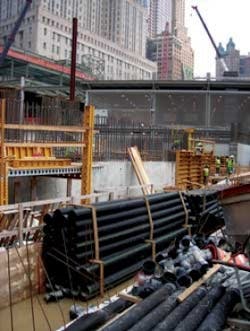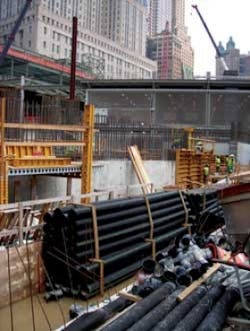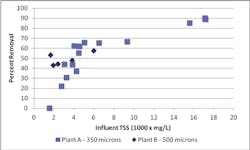Trees Grow Where Tragedy Reigned
World Trade Center Memorial Plaza garden to be a green environment with self-contained water and drainage system
One of the design goals and part of the contract for the construction of the World Trade Center Memorial Plaza was the requirement to use materials, practices and procedures that would enable the project to earn a LEED™ building gold rating from the U.S. Green Building Council (USGBC). The Plaza will have more than 400 trees on top of the area that was the basement of the two buildings destroyed on September 11, 2001. The self-sustaining topiary design will use a stormwater drainage and storage system to collect water and help irrigate the park setting.
For the drainage system, corrugated high-density polyethylene (HDPE) pipe from Advanced Drainage Systems Inc. (ADS) was selected due to its strength, optimum hydraulic capacity and environmental attributes.
Designed as a grid and installed 85 feet underneath, the drainage system for the 3.5-acre site uses more than 1.5 miles of corrugated HDPE pipe. Additionally, the company fabricated several hundred tees, wyes and reducers for the job.
The pipe is perforated to allow water seeping from the ground to enter the system and flow into sumps constructed beneath the floor slab.
The perimeter of the drainage system uses 2,400 feet of 10-inch diameter and 2,100 feet of 8-inch diameter ADS N-12® perforated pipe. Another 3,100 feet of the non-perforated pipe carries the water to sumps under the floor slab.
The perforated pipe is wrapped in a geotextile fabric that blocks sand and other fines while allowing the water to pass through. The pipe is also being used to provide foundation drainage for the new buildings.
N-12 pipe can help a project become certified through the USGBC LEED program. For a project to qualify, it must be registered with USGBC and designed in accordance with green building techniques as prescribed by the LEED rating system.
Carbon footprint is the most widely accepted measure of the environmental impact of activity or production in terms of greenhouse gases produced, which is measured in units of carbon dioxide. Due to its design and high strength-to-weight ratio, corrugated HDPE pipe produces a smaller impact on the environment than traditional pipe materials, such as reinforced concrete or corrugated metal. A 2006 study by the Department of Mechanical Engineering at the University of Bath in the United Kingdom found that reinforced concrete, for example, has a carbon footprint approximately three times that of HDPE pipe.
“Being a steward of the environment is integral to ADS,” stated Tori Durliat, director of marketing for ADS. “Protecting our habitat is at the very root of our company. In 1967 ADS started making HDPE pipe that would last longer, and would safeguard the water supply and soil while being easy and cost-effective to use.
“We produce many green-friendly systems and products. And we fully plan to keep meeting the demands of our world with more of these types of products. It is indeed an honor to be part of the World Trade Center Memorial project.”
About the Company:
Advanced Drainage Systems Inc. (ADS) serves the stormwater drainage and on-site industry through a global network of 42 domestic and international manufacturing plants and more than 30 distribution centers.


